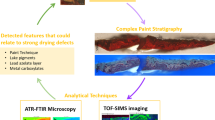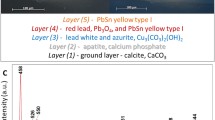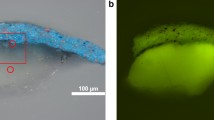Abstract
The formation and distribution of metal soaps produced as a result of the reactivity and aging of the materials in a fifteenth-century egg tempera and oil paintings on wood are presented. The painting technique involves the application of several paint layers over a ground using, sometimes in the same paint layer sequence, drying oil and egg yolk binders. We show, with a selection of examples, how the use of thin sections and a combination of various micro-sensitive analytical techniques is adequate to obtain the high-quality data necessary for the unambiguous identification of metal soaps and metal oxalates as well as their distribution in the paint layers. The techniques include micro infrared spectroscopy (μSR-FTIR) and micro X-ray diffraction (μSR-XRD) with synchrotron radiation, optical microscopy (OM), and scanning electron microscopy with energy dispersive X-ray spectroscopy (SEM-EDS). The data obtained sheds light about the underlying reaction and aging mechanisms happening in each paint layer and among them. This helps to define the state of conservation of the artworks.
Access this chapter
Tax calculation will be finalised at checkout
Purchases are for personal use only
Similar content being viewed by others
References
Bayrak A, Kiralam M, Ipek A et al (2010) Fatty acid compositions of linseed (Linum Usitatissimum L.) genotypes of different origin cultivated in Turkey. Biotechnol Biotechnol Equip 24(2):1836–1842
Beltran V, Salvadó N, Butí S et al (2015) Optimal sample preparation for the analysis of micrometric heterogeneous samples. Anal Chem 87:6500–6504
Boon JJ, Gore E, Keune K et al (2005) Image analytical studies of lead soap aggregates and their relationship to lead and tin in 15th C lead tin yellow paints from the Sherborne triptych. In: Picollo M (ed) Sixth infrared and Raman users group, Florence, Mar–Apr 2004, Il Prato, pp 66–74
Bucklow S (2012) The classification of craquelure patterns. In: Hill Stoner J, Rushfield R (eds) Conservation of easel paintings, Series in conservation and museology. Routledge, London/New York, pp 285–290
Catalano J, Murphy A, Yao Y et al (2014) 207Pb and 119Sn solid-state NMR and relativistic density functional theory studies of the historic pigment lead-tin yellow type I and its reactivity in oil paintings. J Phys Chem A 118:7952–7958
Catalano J, Murphy A, Yao Y et al (2015) Coordination geometry of lead carboxylates-spectroscopic and crystallographic evidence. Dalton Trans 44:2340–2347
Cinque G, Frogley M, Wehbe K (2011) Multimode InfraRed imaging and microspectroscopy (MIRIAM) beamline at diamond. Synchrotron Radiat News 24(5):24–33
Corbeil MC, Robinet L (2002) X-ray powder diffraction data for selected metal soaps. Powder Diffract 17(1):52–60
Cotte M, Checroun E, Susini J et al (2007) Micro-analytical study of interactions between oil and lead compounds in paintings. Appl Phys A Mater Sci Process 89:841–848
Cotte M, Checroun E, Nolf WD et al (2016) Lead soaps in paintings: friends or foes? Stud Conserv 62(1):2–23
de Viguerie L, Payard PA, Portero E (2016) The drying of linseed oil investigated by Fourier transform infrared spectroscopy: historical recipes and influence of lead compounds. Prog Org Coat 93:46–60
Erhardt D, Tumosa CS, Mecklenburg MF (2005) Long term chemical and physical processes in oil paint films. Stud Conserv 50(2):43–150
Helwig K, Poulin J, Corbeil MC et al (2014) Conservation issues in several twentieth-century Canadian oil paintings: the role of zinc carboxylate reaction products. In: Van den Berg KJ, Burnstock A, de Tagle A, de Keijzer M, Heydenreich G, Krueger J, Learner T (eds) Issues in contemporary oil paints. Springer, Cham, pp 167–184
Hermans JJ, Keune K, Van Loon A et al (2014) The molecular structure of three types of long-chain zinc (II) alkanoates for the study of oil paint degradation. Polyhedron 81:335–340
Hermans JJ, Keune K, Van Loon A et al (2015) An infrared spectroscopic study of the nature of zinc carboxylates in oil paintings. J Anal At Spectrom 30:1600–1608
Hermans JJ, Keune K, Van Loon A et al (2016) The crystallization of metal soaps and fatty acids in oil paint model systems. Phys Chem Chem Phys 18:10896–10905
Higgitt C, Spring M, Saunders D (2003) Pigment-medium interactions in oil paint films containing red lead or lead-tin yellow. Natl Gallery Tech Bull 24:75–93
Juanhuix J, Gil-Ortiz F, Cuni G et al (2014) Developments in optics and performance at BL13-XALOC, the macromolecular crystallography beamline at the ALBA synchrotron. J Synchrotron Radiat 21:679–689
Keune K, Boon JJ (2004) Imaging secondary ion mass spectrometry of a paint cross section taken from an early Netherlandish painting by Rogier van der Weyden. Anal Chem 76: 1374–1385
Keune K, Boon JJ (2007) Analytical imaging studies of cross-sections of paintings affected by lead soap aggregate formation. Stud Conserv 52(3):161–176
Keune K, Loon A, Boon JJ (2011) SEM backscattered-Electron images of paint cross sections as information source for the presence of the lead white pigment and lead-related degradation and migration phenomena in oil paintings. Microsc Microanal 17(5):696–701
Keune K, Kramer RP, Huijbregts Z et al (2016) Pigment degradation in oil paint induced by indoor climate: comparison of visual and computational backscattered Electron images. Microsc Microanal 22(2):448–457
Mancilla N, D’Antonio MC, González-Baró AC et al (2009) Vibrational spectra of lead(II) oxalate. J Raman Spectrosc 40:2050–2052
Martínez-Casado FJ, Ramos-Riesco M, Rodríguez-Cheda JA et al (2014) Short lead (II) soaps: from weakly fluorescent crystals to strongly phosphorescent and structurally varied vitreous phases. A thermal, structural and spectroscopic study. J Mater Chem C 2:9489–9496
Meilunas RJ, Bentsen JG, Steinberg A (1990) Analysis of aged paint binders by FTIR spectroscopy. Stud Conserv 35(1):33–51
Mills JS, White R (1994) The organic chemistry of museum objects, 2nd edn. Butterworth-Heinemann, Oxford
Monico L, Rosi F, Miliani C (2013) Non-invasive identification of metal-oxalate complexes on polychrome artwork surfaces by reflection mid-infrared spectroscopy. Spectroc Acta Pt A-Molec Biomolec Spectr 116:270–280
Newman R (1998) Tempera and other non-drying-oil media. In: Dorge V, Carey Howlett F (eds) Painted wood: history and conservation. The Getty Conservation Institute, Los Angeles, pp 33–63
Osmond G, Boon JJ, Puskard L (2012) Metal stearate distributions in modern artists’ oil paints: surface and cross-sectional investigation of reference paint films using conventional and synchrotron infrared microspectroscopy. Appl Spectrosc 66:1136–1144
Pereira RFP, Valente AJM, Fernandes M et al (2012) What drives the precipitation of long-chain calcium carboxylates (soaps) in aqueous solution? Phys Chem Chem Phys 14(20):7517–7527
Pereira RFP, Valente AJM, Burrows HD (2014) The interaction of long chain sodium carboxylates and sodium dodecylsulfate with lead(II) ions in aqueous solutions. J Colloid Interface Sci 414:62–72
Popa VM, Gruia A, Raba D, Moldovan C et al (2012) Fatty acids composition and oil characteristics of linseed (Linum Usitatissimum L.) from Romania. J Agroaliment Process Technol 18(2):136–140
Pouyet E, Fayard B, Salomé M et al (2015) Thin-sections of painting fragments: opportunities for combined synchrotron-based micro-spectroscopic techniques. Herit Sci 3:3. https://doi.org/10.1186/s40494-014-0030-1
Richardin P, Mazel V, Walter P et al (2011) Identification of different copper green pigments in renaissance paintings by cluster-TOF-SIMS imaging analysis. J Am Soc Mass Spectrom 22:1729–1173
Robinet L, Corbeil MC (2003) The characterization of metal soaps. Stud Conserv 48:23–40
Salvadó N, Butí S, Tobin MJ et al (2005) Advantages of the use of SR-FT-IR Microspectroscopy: applications to cultural heritage. Anal Chem 77:3444–3451
Salvadó N, Butí S, Nicholson J et al (2009) Identification of reaction compounds in micrometric layers from gothic paintings using combined SR-XRD and SR-FTIR. Talanta 79:419–428
Salvadó N, Butí S, Labrator A et al (2011) SR-XRD and SR-FTIR study of the alteration of silver foils in medieval paintings. Anal Bioanal Chem 399:3041–3052
Salvadó N, Butí S, Cotte M et al (2013) Shades of green in 15th century paintings: combined microanalysis of the materials using synchrotron radiation XRD, FTIR and XRF. Appl Phys A-Mater 111:47–57
Sawicka A, Burnstock A, Izzo FC et al (2014) An investigation into the viability of removal of lead soap efflorescence from contemporary oil paintings. In: Van den Berg KJ, Burnstock A, de Tagle A, de Keijzer M, Heydenreich G, Krueger J, Learner T (eds) Issues in contemporary oil paints. Springer, Cham, pp 311–332
Sotiropoulou S, Papliaka ZE, Vaccari L (2016) Micro FTIR imaging for the investigation of deteriorated organic binders in wall painting stratigraphies of different techniques and periods. Microchem J 124:559–567
USDA National Nutrient Database for Standard Reference, Release 1 (April, 2018) Full Report (All Nutrients): 01137, Egg, yolk, dried
Van Loon A, Noble P, Burnstock A (2012) Ageing and deterioration of traditional oil and tempera paints. In: Hill Stoner J, Rushfield R (eds) Conservation of easel paintings, series in conservation and museology. Routledge, London/New York, p 229
Acknowledgments
The project received financial support from MINECO (Spain), Grant MAT2013-41127 R, and Generalitat de Catalunya, Grant 2014SGR-581. We acknowledge Diamond Light Source for time on beamline MIRIAM B22 under Proposal (SM10400) and the collaboration of Diamond staff. The μSR-XRD experiments were performed at BL13 XALOC beamline (Grant No. 2014071016) at ALBA Synchrotron with the collaboration of ALBA staff. Part of this work was carried out with collaboration between the Universitat Politècnica de Catalunya (UPC) and the “Museu Nacional d’Art de Catalunya” (MNAC) and the “Centre de Restauració de Béns Mobles de Catalunya” (CRBMC).
Author information
Authors and Affiliations
Corresponding author
Editor information
Editors and Affiliations
Rights and permissions
Copyright information
© 2019 Crown
About this chapter
Cite this chapter
Salvadó, N., Butí, S., Pradell, T., Beltran, V., Cinque, G., Juanhuix, J. (2019). Identification and Distribution of Metal Soaps and Oxalates in Oil and Tempera Paint Layers in Fifteenth-Century Altarpieces Using Synchrotron Radiation Techniques. In: Casadio, F., et al. Metal Soaps in Art. Cultural Heritage Science. Springer, Cham. https://doi.org/10.1007/978-3-319-90617-1_11
Download citation
DOI: https://doi.org/10.1007/978-3-319-90617-1_11
Published:
Publisher Name: Springer, Cham
Print ISBN: 978-3-319-90616-4
Online ISBN: 978-3-319-90617-1
eBook Packages: Chemistry and Materials ScienceChemistry and Material Science (R0)




